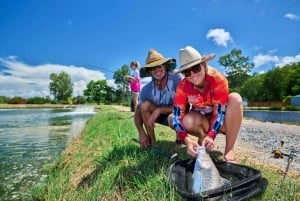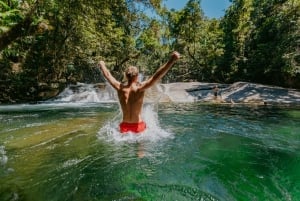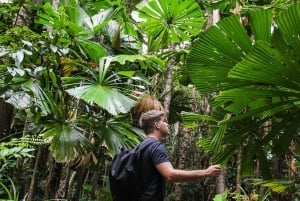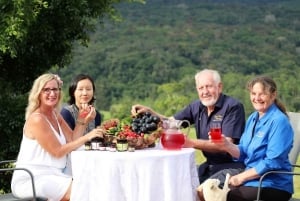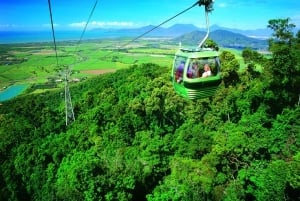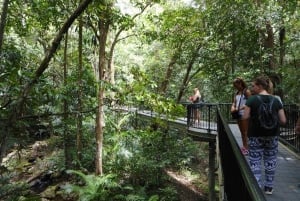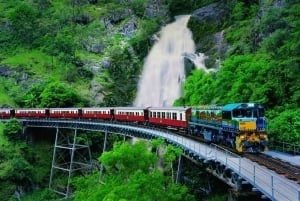Cairns Regional Information
Tropical North Queensland
This vast and diverse region has plenty to offer the short holiday maker or for those with longer stays in mind. Prime industry on the coastal region is sugar cane production and milling, tropical fruit and tea production, tourism and the support services associated with all.
The Great Barrier Reef, Daintree Rainforest (both World Heritage listed), and the Undara Lava Tubes are a few of many wonderful locations not to be missed on a visit to Australia’s Tropical North.
Activities are too numerous to single out (there are over 600 tour options in the region) but everyone can fill in at least a 2 week stay by doing something a bit different each day. From Cairns there are coach tours to inland and tableland centres visiting the sights and wineries, as well as trips to Cooktown and the Daintree. For Train buffs there are two unique and wonderful trips into Savannah and Gulf (of Carpentaria) country and a train museum visit to top off a journey from Brisbane on the "Sunlander" or the "Tilt Train". You can take a flight to deliver the mail to remote stations and towns; take a motorbike excursion from Cairns to the tip of Cape York and visit all the communities in between. Visit the Royal Flying Doctor Service, and see how they operate to service the outback of Queensland. Fishing is a great activity for the family or for a "guy’s holiday", ½ or full day tours and live aboard trips. Aboriginal Culture is on display at cultural parks, museums and art galleries as well as the communities - some you may visit with permission from the elders.
The rainforest extends from Cooktown to past Tully in the south and some areas can be visited by self driving, but to see the best it is advisable to take a tour as the operators have licenses and permits to get into closed National Parks or private property. This wet tropics area was World Heritage listed in 1988 and there are many small pockets where rare flora and fauna exist and some are still waiting to be found and identified - to biologist’s joy worldwide.
The people of this region have primarily an outdoor lifestyle. Picnics or barbeques are a daily affair on the esplanades of Cairns and the beaches and many of the inland points of interest. The Regional Councils supply electric barbeques free of charge. All that is asked of you is to ensure you clean up thoroughly and leave the area ready for the next group.
Cairns Beaches: (Ellis; Palm Cove; Clifton; Trinity; Kewarra; Yorkey’s Knob, Holloways & Machans Beaches). There are eight beaches to the north of Cairns – 15 to 30 minutes drive – where swimming and other water sports can be experienced. Rental accommodation is plentiful. Bus service to Cairns is good; a taxi can be expensive depending on the number travelling.
Port Douglas: About 50 minutes scenic drive north of Cairns, this town is a well known tourist destination. 4 Mile beach is popular with locals & visitors. Golf can be played at Mirage Country Club’s world class course or at the Sea Temple course. "Port" also celebrates annually for 10 days with "Carnivale" occurring each year in May. On Sunday mornings the Port Douglas markets are held with a variety of goods available - if staying in Cairns a great day can be had by traveling with a local airport or tour shuttle from Cairns to Port Douglas an umber of times each day.
Kuranda: a small village in the rainforest to the west of Cairns in the highlands and forming the Eastern Gateway to the Atherton Tablelands, near the end of the Barron Gorge. Visit by travelling on the Kuranda Scenic Train , Skyrail or hop a coach tour. There are a number of attractions to include in a day tour, including a walk to the Barron Falls. Kuranda Rail Station is festooned with a variety of tropical Ferns, orchids and other plants and is worth a visit. The village shops usually begin closing just after the last train departs.
The Atherton Tableland: is the main agricultural region for the area to the west of Cairns, formerly tobacco was the prime crop followed by dairying. These days production is more diverse, farmers are turning to tropical fruits and nuts, coffee, tea and their by-products and a larger interest in commercial vegetable crops. There are only 3 roads into the tableland and you can see the change from rainforest to savannah vegetation on the way. Many tours include visits to the primary producers where you can sample their products. There are many sites of interest in this area; Granite Gorge, fauna sanctuaries, wineries and a distillery, Go Kart racing track, railway museum, aviation & military museum and much more.
Atherton; Yungaburra; Mareeba; Tolga; Milla Milla; these towns are all slightly different and can be included in a self drive tour of the region. Each town has something different and special to offer in its district. Chillagoe is an old mining settlement and currently a marble quarry and the limestone caves share the limelight, with bird watching, fossils and unique rock formations.
Daintree / Cape Tribulation region: "where the rainforest meets the sea", self drive or take a day tour; stay overnight at a choice of many different types of accommodation; visit the reef; tour some of the most remote areas by 4WD guided tours, or do a bit of "croc spotting" in the Daintree River or even "surf through the jungle canopy". Drive about 2 – 21/2 hrs north of Cairns, there is a ferry crossing the Daintree river which can take up a few minutes extra time.
Innisfail: Came to worldwide notice a couple of years ago when Cyclone "Larry" visited devastation on the area. Innisfail is now back to normal with most signs of destruction now gone. This area is primarily agricultural – sugar cane, bananas, dairy and some beef production. Drive about 1 - 1.5 hrs south of Cairns on the Bruce Highway. Visit Paronella Park for a view back in time.
Mission Beach: situated to the south east of Innisfail. This is a delightful area to visit; lovely sandy beaches, off shore islands to visit for the day or to stay over. South Mission Beach is the favoured area for holiday accommodation and the departure point for Dunk & Bedarra Islands.
Cardwell: A small town on the highway, it is a couple of hours drive south of Cairns. This is a good place for a breakfast stop if travelling south or even to overnight there if driving north. Also is a good place for fishing and diving in the sheltered waters of the Hinchinbrook channel. Visit the old Post Office & bush Telegraph Station (heritage listed) for a view of how Cardwell life was in the 1870’s.
Cooktown: The place where Captain James Cook’s ship "Endeavor" was beached for repairs is marked in the town centre. Fishing and tourism are the main activities but there are some cattle stations nearby. The Fishing is legendary.
Undara & Innot Hot Springs: Visit the renowned Undara Lava Tubes, part of the longest lava flow from a single volcanic crater on Earth. In the Microbat breeding season you can witness the unique spectacle of the Microbats and the Night Tigers. Each year the outback lights up at Undara with the spectacular sounds of Opera in the Outback, and again for the annual Outback Country, Rock and Blues festival.
Innot Hot Springs has a little creek that flows with thermal heated water. It’s shallow enough for kids to paddle in and is a warm temperature all year round. Be careful though - in some spots it is warm enough to cook an egg! The springs are said to have therapeutic qualities and a number of people return to Innot Hot Springs on a yearly basis. Innot Hot Springs is only a short drive from Ravenshoe and if you're on the way to Undara is definitely worth stopping in at.
Cape York: Accessible by road only during the dry season (Cape Development Road), some rivers are tidal and care needs to be taken at fords. During the wet season travel is by air or coastal vessels only to much of this region. Karumba and Normanton: These towns are in the "Gulf Country" (Gulf of Carpentaria) of the "Top End" of Australia, are remote and rural. Kurumba is a fishing port and a favoured gathering point for photographers of wetland wildlife and those chasing the Baramundi fishing season. Normanton is the end of the line for the "Gulflander" train and the town servicing the region.


